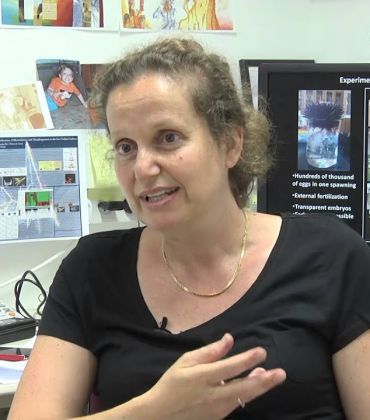
Prof. Smadar Ben Tabou de Leon
Head of the Marine Biology Department
Laboratory: Gene Regulation in Development Lab
Phone: +972-4-8288555
Office: 269, Multipurpose Building
Email: sben-tab@univ.haifa.ac.il
Prof. Smadar Ben-Tabou de-Leon obtained her PhD degree at the Racah Institute of Physics, at the Hebrew University in Jerusalem, on the optical properties of thin layers of semiconductors. She then did a first post-doctorate fellowship on the use of porous silicon surfaces for the detection of neural activity, under the supervision of Prof. Amir Sa’ar at the Hebrew University. In her second post-doctorate at the lab of Prof. Eric Davidson at Caltech, she made the transition to developmental and evolutionary biology and investigated the regulatory networks that drive the development of the sea urchin embryo. In 2012 she started her own laboratory at the University of Haifa, where she studies the biological regulation of biomineralization in the sea urchin larva. Her lab discovered that the molecular control of the sea urchin larval skeleton is similar to the regulation of blood vessel formations in vertebrates and humans. This illuminates how biomineralization evolved rapidly by co-opting ancestral developmental programs for organic scaffolds. Prof. Ben-Tabou de-Leon is currently the head of the Department of Marine Biology at the Charney school of Marine Sciences. She has published more than 30 peer-reviewed papers in theoretical and applied physics and biological sciences. Her work significantly contributed to the understanding of the genetic and cellular regulation of developmental processes and to the evolution of biomineralization. She is an associate editor of Frontiers in Ecology and Evolution and Frontiers in Cell and Developmental Biology. She is married, has four kids, two cats and on her spare time she likes playing pokemon-go, jogging and hiking.
Networks of regulatory genes control the differential expression of regulatory and structural genes and by that initiate and control the development of the body plan. Evolutionary changes of the functional organization of developmental gene regulatory networks are therefore the key molecular mechanism underlying evolutionary change of animal morphology. However, the relation between gene regulatory networks and the developmental tasks they execute is not always apparent: How do gene regulatory networks control complex developmental processes? How do changes in the regulatory circuitry translate into morphological changes and how do they lead to evolutionary innovations in the body plan? These questions lay at the most fundamental level of our understanding of developmental processes and their evolution. I address these questions by studying regulatory circuits that control specification, differentiation and morphogenesis in the sea urchin embryo and comparing them to regulatory circuits that control similar processes in in other organisms. In my work I combine novel high-through put experimental techniques with mathematical modeling, to further our understanding of the dynamic molecular control of developmental processes and their evolution.
Read more on the Gene Regulation in Development and Evolution laboratory webpage.




